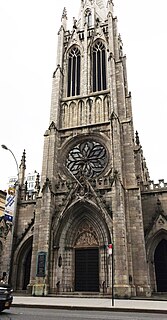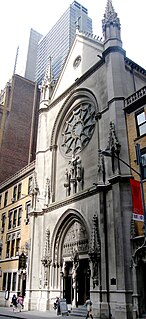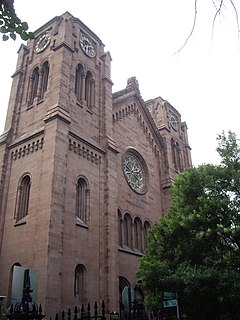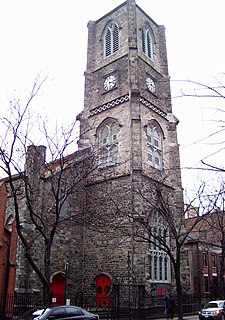Trinity Church is a historic parish church in the Episcopal Diocese of New York, at the intersection of Wall Street and Broadway in the Financial District of Lower Manhattan in New York City. Known for its history, location, architecture and endowment, Trinity is a traditional high church, with an active parish centered around the Episcopal Church and the worldwide Anglican Communion in missionary, outreach, and fellowship. In addition to its main facility, Trinity operates two chapels: St. Paul's Chapel, and the Chapel of St. Cornelius the Centurion on Governors Island. The Church of the Intercession, the Trinity Chapel Complex and many other of Anglican congregations in Manhattan were part of Trinity at one point.

The Jefferson Market Branch of the New York Public Library, once known as the Jefferson Market Courthouse, is a National Historic Landmark located at 425 Avenue of the Americas, on the southwest corner of West 10th Street, in Greenwich Village, Manhattan, New York City, on a triangular plot formed by Greenwich Avenue and West 10th Street. It was originally built as the Third Judicial District Courthouse from 1874 to 1877, and was designed by architect Frederick Clarke Withers of the firm of Vaux and Withers.

Grace Church is a historic parish church in Manhattan, New York City which is part of the Episcopal Diocese of New York. The church is located at 800–804 Broadway, at the corner of East 10th Street, where Broadway bends to the south-southeast, bringing it in alignment with the avenues in Manhattan's grid. Grace Church School and the church houses—which are now used by the school—are located to the east at 86–98 Fourth Avenue between East 10th and 12th Streets.

The Church of Saint Mary the Virgin is an Episcopal Anglo-Catholic church in Midtown Manhattan, New York City, which is part of the Episcopal Diocese of New York of the Episcopal Church in the United States of America. The church complex is located in the heart of Times Square at 133-145 West 46th Street, with other buildings of the complex at 136-144 West 47th Street, between Sixth and Seventh Avenues. It is colloquially known as "Smoky Mary's" because of the amount of incense used in the services.

The Bialystoker Synagogue at 7–11 Bialystoker Place, formerly Willett Street, between Grand and Broome Streets in the Lower East Side neighborhood of Manhattan, New York City is an Orthodox Jewish synagogue. The building was constructed in 1826 as the Willett Street Methodist Episcopal Church; the synagogue purchased the building in 1905.

Grand Street is a street in Lower Manhattan, New York City, United States. It runs west/east parallel to and south of Delancey Street, from SoHo through Chinatown, Little Italy, the Bowery, and the Lower East Side. The street's western terminus is Varick Street, and on the east it ends at the service road for the FDR Drive.

Henry Street is a street in the Lower East Side of the New York City borough of Manhattan that runs one-way eastbound, except for two small two-way segments west of Pike Street and east of Montgomery Street. It spans from Oliver Street in the west, passing underneath the Manhattan Bridge and on to Grand Street in the east ("north"). The street is named for Henry Rutgers, a hero of the American Revolutionary War and prominent philanthropist. Rutgers Street, which intersects with Henry Street, is also named for him.

St. George's Episcopal Church is a historic church located at 209 East 16th Street at Rutherford Place, on Stuyvesant Square in Manhattan, New York City. Called "one of the first and most significant examples of Early Romanesque Revival church architecture in America", the church exterior was designed by Charles Otto Blesch and the interior by Leopold Eidlitz. It is one of the two sanctuaries of the Calvary-St. George's Parish.

The E.V. Haughwout Building is a five-story, 79-foot tall commercial loft building in the SoHo neighborhood of Manhattan, New York City, at the corner of Broome Street and Broadway. Built in 1857 to a design by John P. Gaynor, with cast-iron facades for two street-fronts provided by Daniel D. Badger's Architectural Iron Works, it originally housed Eder V. Haughwout's fashionable emporium, which sold imported cut glass and silverware as well as its own handpainted china and fine chandeliers, and which attracted many wealthy clients – including Mary Todd Lincoln, who had new official White House china painted here. It was also the location of the world's first successful passenger elevator.

St. James' Roman Catholic Church is located at 32 James Street between St. James Place and Madison Street in the Two Bridges neighborhood of Lower Manhattan, New York City. It is the second oldest Roman Catholic building in the city, built in 1835–1837 of fieldstone, with a pair of Doric columns flanking the entrance. While the neo-classical church is modeled on the published designs by Minard Lefever, and is sometimes attributed to him, there is no hard evidence of this being true. The building was once topped by a domed cupola.

Central Synagogue is a Reform synagogue located at 652 Lexington Avenue, at the corner of East 55th Street in Midtown Manhattan, New York City. It was built in 1870–1872 and was designed by Henry Fernbach in the Moorish Revival style as a copy of Budapest's Dohány Street Synagogue. It has been in continuous use by a congregation longer than any other in the state of New York, except Congregation Berith Sholom in Troy, New York, and is among the oldest existing synagogue buildings in the United States.

The John Street United Methodist Church – also known as Old John Street Methodist Episcopal Church – located at 44 John Street between Nassau and William Streets in the Financial District of Manhattan, New York City was built in 1841 in the Georgian style, with the design attributed to William Hurry and/or Philip Embury. The congregation is the oldest Methodist congregation in North America, founded on October 12, 1766 as the Wesleyan Society in America.

The Church of the Immaculate Conception and Clergy House at 406–412 East 14th Street between First Avenue and Avenue A in the East Village neighborhood of Manhattan, New York City were built in 1894–1896 by Grace Church, one of the most prominent Episcopal churches in the city at the time. The buildings were a free chapel – meaning there was no pew rent – called Grace Chapel and a connected Grace Hospital, which could serve 16 senior citizens and 10 children, and was physically connected to the chapel by a bridge, so that patients could be wheeled to services.

The Metropolitan Baptist Church, located at 151 West 128th Street on the corner of Adam Clayton Powell Jr. Boulevard in the Harlem neighborhood of Manhattan, New York City, was originally built in two sections for the New York Presbyterian Church, which moved to the new building from 167 West 111th Street. The chapel and lecture room were built in 1884-85 and were designed by John Rochester Thomas, while the main sanctuary was constructed in 1889-90 and was designed by Richard R. Davis, perhaps following Thomas's unused design. A planned corner tower was never built.

The Church of the Transfiguration is a Roman Catholic parish located at 25 Mott Street on the northwest corner of Mosco Street in the Chinatown neighborhood of Manhattan, New York City. The parish is under the authority of the Archdiocese of New York and is staffed by the Maryknoll order.

The New York County Lawyers' Association Building is a structure at 14 Vesey Street between Broadway and Church Street in the Financial District of Manhattan, New York City. It was built in 1929–30 and was designed by architect Cass Gilbert in the English Georgian style for the Association, which was founded in 1908. Gilbert's design complements Trinity Church's St. Paul's Chapel, which sits across the street.

St. Philip's Episcopal Church is a historic Episcopal church located at 204 West 134th Street, between Adam Clayton Powell Jr. Boulevard and Frederick Douglass Boulevard in the Harlem neighborhood of Manhattan, New York City. Its congregation was founded in 1809 by free African Americans worshiping at Trinity Church, Wall Street as the Free African Church of St. Philip. First located in the notorious Five Points neighborhood, it is the oldest black Episcopal parish in New York City. Historically, it was extremely influential both while located in lower Manhattan and as an institution in Harlem, and many of its members have been leaders in the black community. In 2020, it reported 188 members, 111 average attendance, and plate and pledge income of $224,827.

St. Peter's Episcopal Church, Chelsea, familiarly known as St. Peter's Chelsea, is a historic church of the Episcopal Diocese of New York at 346 West 20th Street between Eighth and Ninth Avenues in the Chelsea neighborhood of Manhattan, New York City, began as an outgrowth from the nearby General Theological Seminary, which had been founded in 1827. After some years in which local residents joined students and faculty from the Seminary for services, it became clear than a new, separate congregation was necessary, and this was organized on May 9, 1831.

The First Presbyterian Church, known as "Old First", is a church located at 48 Fifth Avenue between West 11th and 12th Streets in the Greenwich Village neighborhood of Manhattan, New York City. It was built in 1844–1846, and designed by Joseph C. Wells in the Gothic Revival style. The south transept of the building was added in 1893–1894, and was designed by the firm of McKim, Mead & White. The church complex, which includes a parish house – now referred to as the "South Wing" – on West 11th Street and a church house on West 12th Street designed by Edgar Tafel, is located within the Greenwich Village Historic District.

The First Church of Christ, Scientist in Manhattan is a 1903 building located at Central Park West and 96th Street in the Upper West Side of Manhattan, New York City. The building is a designated New York City landmark.



























